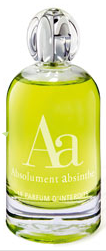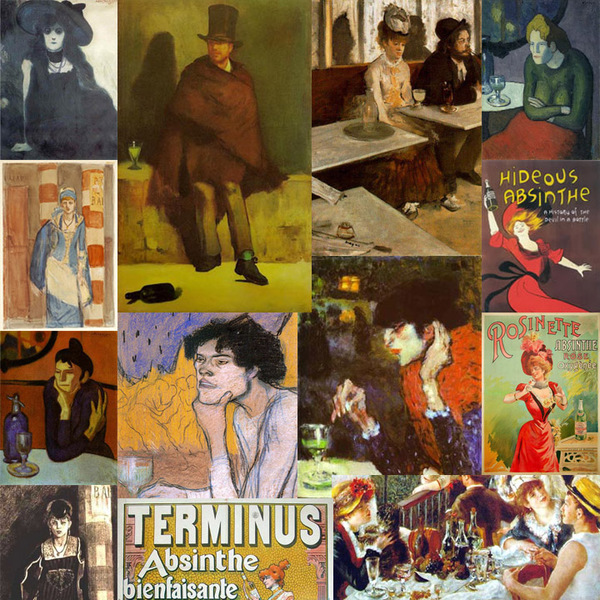Absolument Absinthe by Absolument {Perfume Review & Musings}
Absolument Absinthe (Absolutely Absinthe) is the name chosen by its creators to visibly convey the sense of individual passion that motivated the creation of a perfume inspired by the mythological wormwood-based drink resurrected in France in the early 1990s. The name, like that of L'Artisan Fou D'Absinthe (crazy for absinthe), puts the stress on the atmosphere and mythology of excess that surrounded the consumption of the emerald-green liquor with high alcoholic contents - up to %75 - ultimately leading to its prohibition in France, Switzerland, and the US by 1915.
The popularity of the drink, which was due in part to the pleasurable ritual accompanying it, of slowly imbibing a piece of sugar over a glass partly covered with a slotted spoon leading to the "louching" of the absinthe which would then turn from deep green to cloudy green, also contributed to the demise of quality standards and the proliferation of toxic distillates. By the end of the 19th century, absinthe as a drink had come to symbolize bohemian Paris and anti-bourgeois culture, but also degeneration and death reaching in this manner a final stage in its transformation from a regenerative tonic and cordial to a drink symbolizing the flaws and destructive impulses of humanity....

Back to the 21st century and absinthe perfumes. Absolument Absinthe was created by Pascal Rolland the man behind a modern French adapted version of absinthe alcohol called Versinthe. The scent was created in collaboration with a specialist in aromas from Grasse, Marc Villacèque. The fragrance is said to be composed of 49 ingredients. Top notes are bergamot, black Chinese tea, and cannabis. Heart notes are absinthe (wormwood), cardamom, galbanum, nutmeg, muguet, lotus, ylang-ylang, and jasmine. Base notes are sandalwood and musky notes....
The pictures in the mosaic above, which we collaged using various paintings and advertisements depicting drinkers of absinthe, reveal the different facets of the popular representations of absinthe. Many images hint at depression, madness, and even death. Some others show the lighter, more hygienic, benevolent and even happy side of absinthe. On the one hand there is an absinthe that can be called "hideous", on the other hand there is one described as an "absinthe bienfaisante" under the brand Terminus - a strange name that appears a bit ambiguous - which advertises itself as being the sole healthy absinthe.
From the maker of the gentler Versinthe - as one would have suspected - could only come a "good absinthe" not a demonic one and so it is. Absolument Absinthe is a clean soapy absinthe perfume and a skin perfume. The fragrance makes a stronger impression with time as it is understated, but it has the capacity to grow on the wearer thanks to its body-chemistry-enhancing and skin-binding qualities. Despite its apparent simplicity, the perfume expresses different nuances overtime.
It evolves from a powdery and soapy scent into a bergamot-laced perfume becoming further down the road luminous, soft, and green. When applied the perfume smells initially of mint, greenness, fennel, and wormwood. It offers an impression of being both liquorish-y and fresh. Then it becomes slightly powdery as if there were some violet. The powder accentuates while a dirty musk surfaces. There are pungent herbal undertones. The perfume then becomes more citrus-y and luminous. A sugary black tea accord, please, is very much perceptible. A burnt sugar nuance appears. One then moves into a softer herbal woodsy and green stage. The dry-down is complex and luminous.
We kept thinking Absolument Absinthe reminded us of another scent and that would be Douce Amère by Serge Lutens. It smells of wormwood and fennel/aniseed too and is also soft. Otherwise Douce Amère has a more oriental character and is spicier.
Comparing it to Absinthe by Ava-Luxe, the latter is a dirtier, drier, and a more difficult absinthe scent, if you would prefer to have something more on the dark side.
Absolument Absinthe would fit well into one's beauty arsenal, essentially for its natural skin-scent-enhancing qualities. The aroma of wormwood coupled with cannabis (very soft, not harsh at all) is softly alluring and even on the addictive side.
A 100 ml flacon retails for 101 Euros. You can purchase a 3ml refillable purse spray for 4 Euros to test the perfume. You can find them on Absolument Absinthe website.











I'm so glad to read a review of this scent! I included it in a about Absinthe-inspired beauty products and am glad to hear your point of view. I also included my thoughts on L'Artisan's Fou D'Absinthe.
What were the names of all the pictures you used in the mosaic? I like them, but cant find them.